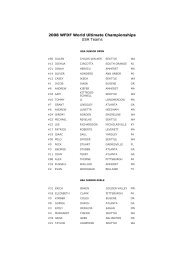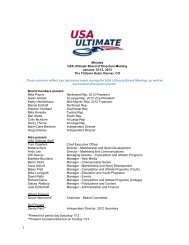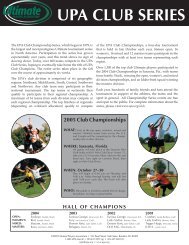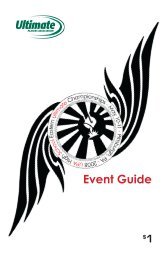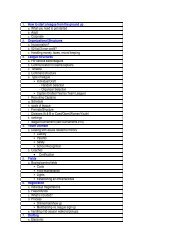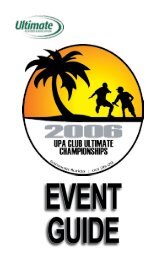From Section 1, Introduction, Item B, Spirit <strong>of</strong> the Game :“<strong>Ultimate</strong> relies upon a spirit <strong>of</strong> sportsmanship that places the responsibility for fair play on theplayer. Highly competitive play is encouraged, but never at the expense <strong>of</strong> mutual respect amongcompetitors, adherence to the agreed upon rules, or the basic joy <strong>of</strong> play. Protection <strong>of</strong> these vitalelements serves to eliminate unsportsmanlike conduct from the <strong>Ultimate</strong> field. Such actions astaunting opposing players, dangerous aggression, belligerent intimidation, intentional infractions,or other win-at-all-costs behavior are contrary to the spirit <strong>of</strong> the game and must be avoided by allplayers.”The UPA website:“Most <strong>Ultimate</strong> players care deeply about Spirit <strong>of</strong> the Game. The organizational challenge for theUPA is to foster an environment where the challenge does not become, "to see what I can get awaywith". Rather than dictate what Spirit <strong>of</strong> the Game is or should be, it is up to each player to do s<strong>of</strong>or him or herself within the context <strong>of</strong> the teams he or she plays with and against.”Most kids have no problem grasping the concept <strong>of</strong> Spirit <strong>of</strong> the Game. As they play, it is importantthat the teacher frequently reinforces this concept. This is best done by stopping play if a disputearises, helping the kids to resolve the matter and then acknowledging their good spirit.Preparing To PlayDivide the class into evenly matched teams, making sure that each team has at least one or two <strong>of</strong>the more-skilled players.• If there are two staff members, they can play on opposing teams.• If there is only one staff member, they might at some point step in and play for one team ifthey happen to be losing badly.• Teachers working with younger kids can also choose to play <strong>of</strong>fense for both teams. In thiscase, their role would be to facilitate the “flow <strong>of</strong> the game.” They should staying more in themiddle <strong>of</strong> the field rather than trying to catch a disc in the end zone for a score.To start the game, each team should line up horizontally along the front <strong>of</strong> their end zone. There isa fun way to determine which team will “receive” (start on <strong>of</strong>fense). The teacher flips two discs andasks a player on one team to call out “same” or “different.” This is the <strong>Ultimate</strong> version <strong>of</strong> a coinflip. Depending on how the discs land, one team will get to decide to receive or “pull” (throw <strong>of</strong>f,like a kick<strong>of</strong>f in football). In real <strong>Ultimate</strong>, the winner could also chose a side <strong>of</strong> the field on whichthey prefer to start. This can be a factor depending on the wind. The team that pulls will be playingdefense to start the first point. Defense is person-on-person and the pulling team should line upacross from the player that they will be guarding.PlayPlay begins with the pull, when someone from the defensive team throws the disc to the <strong>of</strong>fensiveteam. Good pulls stay in the air a long time, giving the defenders time to run down the field andmatch up. If the pull goes out <strong>of</strong> bounds on a fly, the <strong>of</strong>fensive team may start in the middle <strong>of</strong> thefield, at the point where it went out. If the disc lands in and then rolls out, play starts at the spotwhere it went out.• Remember: There is no running with the disc.• Again, in the case <strong>of</strong> an incomplete pass (i.e. bad pass, dropped pass, pass that is interceptedor knocked down by the defense), there is a turnover. This means that the <strong>of</strong>fense becomes thedefense and the defense picks up the disc and heads the other way.14
• Play continues back and forth until one team successfully scores by completing a pass into theend zone.• After a score, the scoring team stays on that side <strong>of</strong> the field and the other team walks back tothe other side. Teams once again line up on their goal lines and the team that scored pulls tostart the new point.<strong>Ultimate</strong> NotesMarking: In <strong>of</strong>ficial <strong>Ultimate</strong>, the defender who is guarding the person with the disc can stand asclose as a disc length away. At this level, however, we recommend that every thrower be given acomfortable space to throw (approx 5 ft) by their defender.Players may not set picks: If at any time, a player runs into another player (even their teammate),they may call out "pick!" At this point, everyone freezes, and the picked player is allowed to repositionthemselves on the field. Picks may be called whether the contact was intentional or unintentional.Players may hold the disc for up to ten seconds: The defender who is guarding (or “marking”) theplayer with the disc must count out loud in order for the time limit to be enforced. When the defendersays the "t" in ten, it is called a "stall." A stall results in a turnover.Players cannot run or walk with the disc: In competitive <strong>Ultimate</strong>, players can’t even move theirpivot foot once it is established. With kids who are just learning the game, this rule usually onlybecomes a factor when a player forgets that they can’t run or walk with the disc. If this happens, theinfraction is called a “travel.” Play stops while the person with the disc resets him or herself.Players may not rip the disc from someone else’s hands: If a player is holding the disc and anotherplayer pulls it from their hands, it is called a “strip.” Play stops and the disc is returned to its rightfulholder.End zone turnovers: If a team takes possession <strong>of</strong> the disc in its own end zone, they may walk thedisc up and begin play at the goal line. If a team commits a turnover inside their own end zone, theother team takes possession at the goal line.Dropped Pulls: In competitive <strong>Ultimate</strong>, if a player tries to catch a pull (as opposed to letting it stopon the ground and picking it up) and drops it, the result is a turnover. When kids are first learningthe game, we suggest that this rule be mentioned, but not enforced.Cutting/Clogging: Many new players fail to realize that they must cut (run into an open space) inorder to be open to receive a pass. “Clogging” results when one or more players are just standingaround the person with the disc, calling “Here! Here! Throw to me!” By emphasizing the idea <strong>of</strong>cutting, you can get kids to begin to “unclog” the playing space. The concept <strong>of</strong> spacing on an <strong>Ultimate</strong>field is something that will evolve for kids as they gain experience playing.More on Cutting: Most effective cuts include a sharp change in direction. The two most commonways <strong>of</strong> cutting are as follows:• Run at the defender to get them <strong>of</strong>f balance and then change direction, running into an openspace.15



